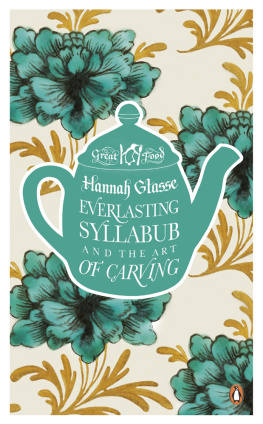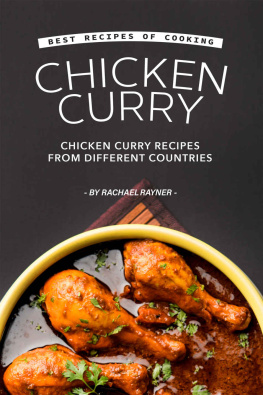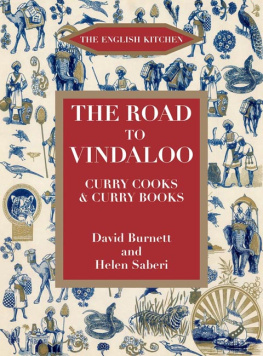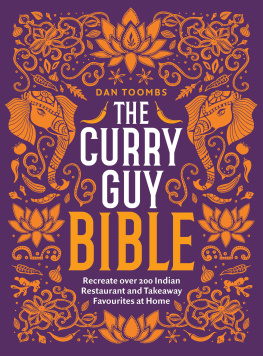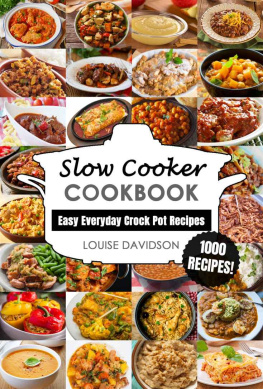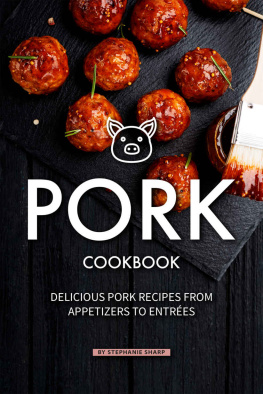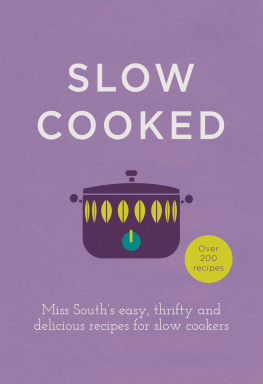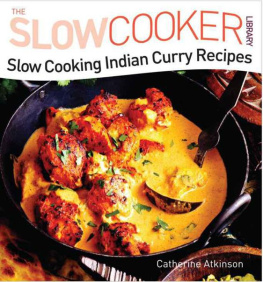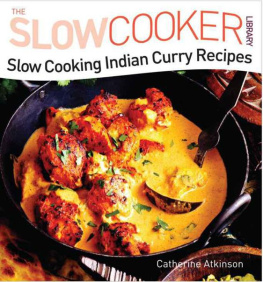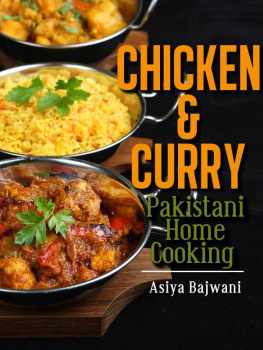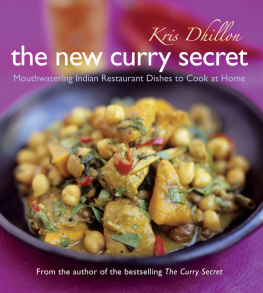Everlasting Syllabub and the Art of Carving
HANNAH GLASSE
PENGUIN BOOKS
PENGUIN BOOKS
Published by the Penguin Group
Penguin Books Ltd, 80 Strand, London WC2R 0RL, England
Penguin Group (USA) Inc., 375 Hudson Street, New York, New York 10014, USA
Penguin Group (Canada), 90 Eglinton Avenue East, Suite 700, Toronto, Ontario, Canada M4P 2Y3 (a division of Pearson Penguin Canada Inc.)
Penguin Ireland, 25 St Stephens Green, Dublin 2, Ireland
(a division of Penguin Books Ltd)
Penguin Group (Australia), 250 Camberwell Road, Camberwell, Victoria 3124, Australia
(a division of Pearson Australia Group Pty Ltd)
Penguin Books India Pvt Ltd, 11 Community Centre, Panchsheel Park, New Delhi 110 017, India
Penguin Group (NZ), 67 Apollo Drive, Rosedale, Auckland 0632, New Zealand
(a division of Pearson New Zealand Ltd)
Penguin Books (South Africa) (Pty) Ltd, 24 Sturdee Avenue, Rosebank, Johannesburg 2196, South Africa
Penguin Books Ltd, Registered Offices: 80 Strand, London WC2R 0RL, England
www.penguin.com
The Art of Cookery Made Plain and Easy first published 1747
This extract published in Penguin Books 2011
All rights reserved
Cover design based on a pattern from a plate by the Bow Porcelain Factory, 1770. Porcelain painted with enamels, moulded and gilded. (Photograph copyright Victoria & Albert Museum.) Picture research by Samantha Johnson. Lettering by Stephen Raw
Except in the United States of America, this book is sold subject to the condition that it shall not, by way of trade or otherwise, be lent, re-sold, hired out, or otherwise circulated without the publishers prior consent in any form of binding or cover other than that in which it is published and without a similar condition including this condition being imposed on the subsequent purchaser
ISBN: 978-0-14-196605-2
PENGUIN BOOKS GREAT FOOD
Everlasting Syllabub and the Art of Carving
HANNAH GLASSE (17081780) is the author of The Art of Cookery Made Plain and Easy, first published in 1747. A bestselling cookbook for over a hundred years, it gave plain and easy instructions for low-cost fine dining and revolutionized the meals of the middle classes. She is considered the mother of the dinner party by Clarissa Dickson-Wright; her trademark dishes include curry and roast hare.
To the Reader
I believe I have attempted a branch of Cookery, which nobody has yet thought worth their while to write upon: but as I have both seen, and found by experience, that the generality of servants are greatly wanting in that point, therefore I have taken upon me to instruct them in the best manner I am capable; and, I dare say, that every servant who can but read, will be capable of making a tolerable good cook, and those who have the least notion of Cookery cannot miss of being very good ones.
If I have not wrote in the high polite style, I hope I shall be forgiven; for my intention is to instruct the lower sort, and therefore must treat them in their own way. For example, when I bid them lard a fowl, if I should bid them lard with large lardoons, they would not know what I meant; but when I say they must lard with little pieces of bacon, they know what I mean. So in many other things in Cookery, the great cooks have such a high way of expressing themselves, that the poor girls are at a loss to know what they mean: and in all Receipt Books yet printed, there are such an odd jumble of things as would quite spoil a good dish; and indeed some things so extravagant, that it would be almost a shame to make use of them, when a dish can be made full as good, or better, without them. For example: when you entertain ten or twelve people, you shall use for a cullis, a leg of veal and a ham; which, with the other ingredients, makes it very expensive, and all this only to mix with other sauce. And again, the essence of ham for sauce to one dish; when I will prove it, for about three shillings I will make as rich and high a sauce as all that will be, when done. For example:
Take a large deep stew-pan, half a pound of ham, fat and lean together, cut the fat and lay it over the bottom of the pan; then take a pound of veal, cut it into thin slices, beat it well with the back of a knife, lay it all over the ham; then have six penny-worth of the coarse lean part of the beef cut thin, and well beat, lay a layer of it all over, with some carrot, then the lean of the ham cut thin and laid over that; then cut two onions and strew over, a bundle of sweet herbs, four or five blades of mace, six or seven cloves, a spoonful of all-spice or Jamaica pepper, half a nutmeg beat, a pigeon beat all to pieces, lay that all over, half an ounce of truffles and morels, then the rest of your beef, a good crust of bread toasted very brown and dry on both sides: you may add an old cock beat to pieces; cover it close, and let it stand over a slow fire two or three minutes, then pour on boiling water enough to fill the pan, cover it close, and let it stew till it is as rich as you would have it, and then strain off all that sauce. Put all your ingredients together again, fill the pan with boiling water, put in a fresh onion, a blade of mace, and a piece of carrot; cover it close, and let it stew till it is as strong as you want it. This will be full as good as the essence of ham for all sorts of fowls, or indeed most made dishes, mixed with a glass of wine, and two or three spoonfuls of catchup. When your first gravy is cool, skim off all the fat, and keep it for use.
This falls far short of the expence of a leg of veal and ham, and answers every purpose you want.
If you go to market, the ingredients will not come to above half a crown; or for about eighteen-pence you may make as much good gravy as will serve twenty people.
Take twelve-penny-worth of coarse lean beef, which will be six or seven pounds, cut it all to pieces, flour it well; take a quarter of a pound of good butter, put it into a little pot or large deep stew-pan, and put in your beef: keep stirring it, and when it begins to look a little brown, pour in a pint of boiling water; stir it all together, put in a large onion, a bundle of sweet herbs, two or three blades of mace, five or six cloves, a spoonful of all-spice, a crust of bread toasted, and a piece of carrot; then pour in four or five quarts of water, stir all together, cover close, and let it stew till it is as rich as you would have it; when enough, strain it off, mix it with two or three spoonfuls of catchup, and half a pint of white wine; then put all the ingredients together again, and put in two quarts of boiling water, cover it close, and let it boil till there is about a pint; strain it off well, add it to the first, and give it a boil together. This will make a great deal of good rich gravy.
You may leave out the wine, according to what use you want it for; so that really one might have a genteel entertainment for the price the sauce of one dish comes to; but if gentlemen will have French cooks, they must pay for French tricks.
A Frenchman in his own country will dress a fine dinner of twenty dishes, and all genteel and pretty, for the expence he will put an English lord to for dressing one dish. But then there is the little petty profit. I have heard of a cook that used six pounds of butter to fry twelve eggs; when every body knows (that understands cooking) that half a pound is full enough, or more than need be used: but then it would not be French. So much is the blind folly of this age, that they would rather be imposed on by a French

